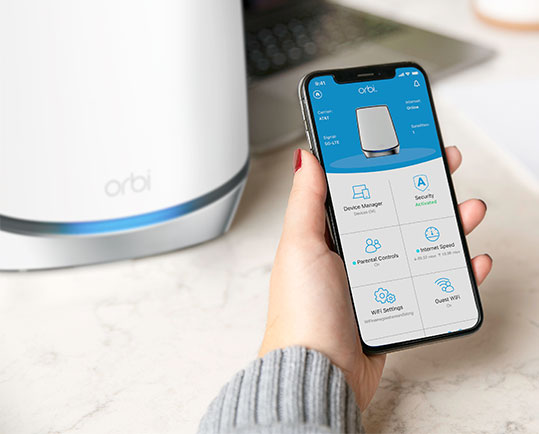

What is Mesh WiFi?
Curious about mesh WiFi? Learn how to get the best WiFi coverage and fastest WiFi speeds throughout your whole home by using multiple devices to create a seamless mesh network.
-
Quick Links
What is a Mesh Network? What are the benefits of Mesh WiFi? What is a Mesh WiFi system? Mesh Network: Advantages and Disadvantages How does Mesh WiFi work? Mesh WiFi vs Extender: What's the difference? What is a Mesh Router? How to set up a Mesh WiFi
WiFi Mesh: An Overview
Mesh WiFi systems are wireless networks that combine a WiFi router with one or more mesh satellites to expand the coverage area of a single WiFi network. In a Mesh WiFi system, connected devices are seamlessly handed off to the router or satellite with the strongest WiFi signal in a given area.
This makes mesh WiFi a great solution for large homes and businesses where a single router will not provide adequate coverage. WiFi 6 and WiFi 6E mesh systems give users great flexibility to place satellites in different areas for optimal WiFi coverage, preventing WiFi “dead spots” throughout your space.
Shop our best Mesh WiFi Systems
Shop Mesh Systems for business
What is a Mesh Network?
A mesh network is a type of local area network (LAN) composed of multiple nodes that work together to broadcast a WiFi signal over a large area. In contrast to WiFi extenders, these nodes (satellites) combine to form a single network with a single login. Dual-band mesh systems use only the 2.4 GHz and 5 GHz bands, whereas tri-band mesh systems and quad-band mesh routers unlock the fastest WiFi speeds.
A tri-band router is a WiFi router that uses the 2.4 GHz band, 5GHz band, and 6GHz band. Tri-band WiFi increases the available WiFi bandwidth to reduce buffering and network congestion. Each wireless node communicates with connected devices directly (phones, smart TVs, tablets, etc.). Each node also talks to any other wireless node that is within range and part of the network, allowing seamless handoff between nodes and optimal performance as you move throughout the space.

What is a Mesh WiFi System?
A mesh WiFi system typically includes a mesh router, which connects to the modem (converting a wired internet connection from the modem to WiFi), and mesh satellites to extend the WiFi signal deeper into the home. In some cases, the cable modem and router are combined in a single unit.
The router and satellites are strategically spaced throughout a home or business to create an overlapping wireless coverage area, allowing strong, continuous WiFi coverage throughout with no dead zones. The best mesh WiFi systems on the market today provide up to 3,000 sq. ft. of coverage per satellite.

How does Mesh WiFi work?
Mesh networks are a type of network where each node (either the mesh router or mesh satellite) can relay data to other nodes in the network, passing it along until it reaches its destination. This is in contrast to traditional wireless networks, where each device is connected to a single, central router.
For a typical user connected to a mesh network, this forwarding of data between nodes is completely seamless; they have the same experience as being connected to a single super-powerful wireless router, with a strong, reliable WiFi signal in every corner of the home.
Mesh satellites are wired or wirelessly connected to the mesh router via a “backhaul”. The quality and speed of the backhaul connection dictates the maximum speed that satellites can supply to connected devices (phones, laptops, etc.).
Did you know?
NETGEAR’s Orbi Mesh WiFi Systems use tri-band or quad-bandwidth with dedicated backhaul for ultra-fast gigabit performance, even with hundreds of devices connected to the satellite access points.

What is a Mesh Router?
Mesh routers are at the heart of a mesh WiFi system. Working with a modem, the WiFi mesh router can create a single, unified signal throughout a home network. One or more mesh satellites can connect wirelessly with each other. Mesh satellites cannot be used without a connection to the main mesh router, but a mesh router can be used without any satellites.

What are the Benefits of Mesh WiFi?
Mesh WiFi offers lots of benefits in comparison to traditional routers, including:
• Mesh WiFi networks automatically configure themselves. You don’t need to set up each individual satellite node.
• Mesh WiFi networks can perform up to ten times faster than traditional routers. With mesh, data is distributed evenly across the entire network to ease traffic congestion.
• Mesh WiFi networks are very reliable. If one signal becomes weak, a nearby satellite will automatically take over so WiFi devices can continue to function seamlessly.

Mesh Network: Advantages and Disadvantages
Advantages:
It’s only worth upgrading to a mesh network if the advantages justify the expense, and NETGEAR mesh WiFi products tick all the right boxes. Here are some significant mesh WiFi advantages.
• Mesh systems provide the fastest internet speeds and easiest-to-use WiFi possible for home and business use.
• A mesh WiFi router is a great way to take full advantage of a 1 Gig or faster internet service plan.
• Powerful mesh WiFi hardware can unlock advanced cybersecurity and internet filtering with parental controls..
• Mesh systems are expandable using additional mesh satellite nodes to eliminate slow coverage areas.
Disadvantages:
Mesh networks have very few disadvantages but there are a few considerations when shopping for a mesh system.
• WiFi devices may experience imperceptible increased latency when data is transmitted between satellite nodes. This is because data has to pass through more nodes to reach the internet, and each node adds a small delay as data is read and retransmitted. Often this small amount of latency is counterbalanced by the reduced device load on each individual mesh satellite compared to a traditional wireless router setup.
• Mesh WiFi Systems are sometimes more expensive than single wireless routers of the same performance class. However, these cost considerations can lead to time and cost-saving vs buying multiple premium extenders and configuring your own network from scratch.
Mesh WiFi vs Extender: What’s the difference?
Mesh WiFi systems are preconfigured out of the box, meaning that once you have the main mesh router unit set up, you can easily add additional mesh satellites and they will all work together. Mesh networks also have a more powerful backhaul than a traditional WiFi Extender. This means that the signal from the main unit to satellites is stronger and can reach further away with less chance of interference and slow-down.
Mesh systems allow for the use of a single SSID (service set identifier) meaning the same WiFi name is always seamlessly available and you don't have to worry about which network your device is connected to – it will always connect to the strongest signal. With a traditional WiFi extender, you have to configure each one separately, which can be complicated and error-prone.

How to set up Mesh WiFi
The setup procedures for different mesh WiFi systems may vary. NETGEAR’s Orbi Mesh WiFi Systems for Home and Orbi Pro for Business offer a hassle-free setup:
1. Connect your Orbi Mesh Router to your modem and place the satellites in the desired locations. The Mesh Router should be placed in the middle of your home (if possible) and the satellites should be placed around the edge of your property in order to provide optimal coverage. Get more Mesh Setup help.
2. Once devices are placed, use the Orbi app or browser login page to configure the router and check which satellite provides the best signal in each room.
For more on mesh satellite placement tips visit - Where should I place my Orbi Mesh Satellites?
Ready to explore more?
Shop our best Mesh WiFi Systems



Meet the Orbi family
Answer a few questions and we'll find the perfect solution for your home
Why buy directly from NETGEAR?

FREE
SHIPPING
![]()
EXCLUSIVE
OFFERS

PRE-PURCHASE
CONCIERGE LIVE CHAT

HASSLE-FREE
RETURNS

